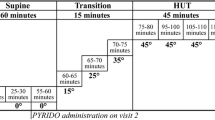Abstract
Background
Spinal cord injury (SCI) is a devastating disease process that can occur as a consequence of motor vehicle collisions, falls, or other traumatic injuries. Persistent bradycardia was found to be universally present in all high cervical SCI patients. Limited data exists to suggest the most effective therapy for the bradycardia associated with high cervical SCI. Treatment includes atropine, epinephrine, dopamine, and even implantable cardiac pacemakers, all of which have their risks and side effects. There are no prospective studies to evaluate methylxanthines for the treatment of bradycardia secondary to cervical SCI.
Methods
We report on four patients in whom Theophylline was successfully used enterally as a second line agent to treat bradycardia secondary to cervical SCI. We also reported on two patients in whom Theophylline was successfully used as a first line agent. Bradycardia resolved in all patients
Results
Theophylline levels were below toxic levels in all of the patients and no side effects from theophylline were observed.
Conclusions
Theophylline’s use via enteral route can successfully and safely treat SCI-related bradycardia, and may help avoid the long term use of inotropic and chronotropic infusions and pacemakers and their associated risks and complications. We strongly recommend further studies to establish the role of this agent as a first line therapy in this specific patient population. Optimal dosing and duration of therapy will also need to be established.
Similar content being viewed by others
References
Lehmann KG, Lane JG, et al. Cardiovascular abnormalities accompanying acute spinal cord injury in humans: incidence, time course and severity. J Am Coll Cardiol. 1987;10(1):46–52.
Giloff IS, Ward SL, Hohn AR. Cardiac pacemaker in high spinal cord injury. Arch Phys Med Rehab. 1991;72(8):601–3.
Segal JL, Pathat MS. Optimal drug therapy and therapeutic drug monitoring after spinal cord injury: a population-specific approach. Am J Ther. 2001;8(6):451–63.
Ruiz-Arango AF, Robinson VJB, Sharma GK. Characteristics of patients with cervical spinal injury requiring permanent pacemaker implantation. Cardiol Rev. 2006;14(4):e8–11.
Schulz-Stubner S. The use of small dose theophylline for the treatment of bradycardia in patients with spinal cord injury. Anesth Analg. 2005;101(6):1809–11.
Pansoori VR, Leesar MA. Use of aminophylline in the treatment of severe symptomatic bradycardia resistant to atropine. Cardiol Rev. 2004;12(2):65–8.
Sakamoto T, Sadanaga T, Okazaki T. Sequential use of aminophylline and theophylline for the treatment of atropine resistant bradycardia after spinal cord injury. J Cardiol. 2007;49(2):91–6.
Whitman CB, Schroeder WS, Ploch PJ, Raghvavendran K. Efficacy of aminophylline for treatment of recurrent symptomatic bradycardia after spinal cord injury. Pharmacotherapy. 2008;28(1):131–5.
Weant KA, Kilpatrick M, Jaikumar S. Aminophylline for the treatment of symptomatic bradycardia and asystole secondary to cervical spine injury. Neurocrit Care. 2007;7:250–2.
Author information
Authors and Affiliations
Corresponding author
Rights and permissions
About this article
Cite this article
Sadaka, F., Naydenov, S.K. & Ponzillo, J.J. Theophylline for Bradycardia Secondary to Cervical Spinal Cord Injury. Neurocrit Care 13, 389–392 (2010). https://doi.org/10.1007/s12028-010-9454-y
Published:
Issue Date:
DOI: https://doi.org/10.1007/s12028-010-9454-y




